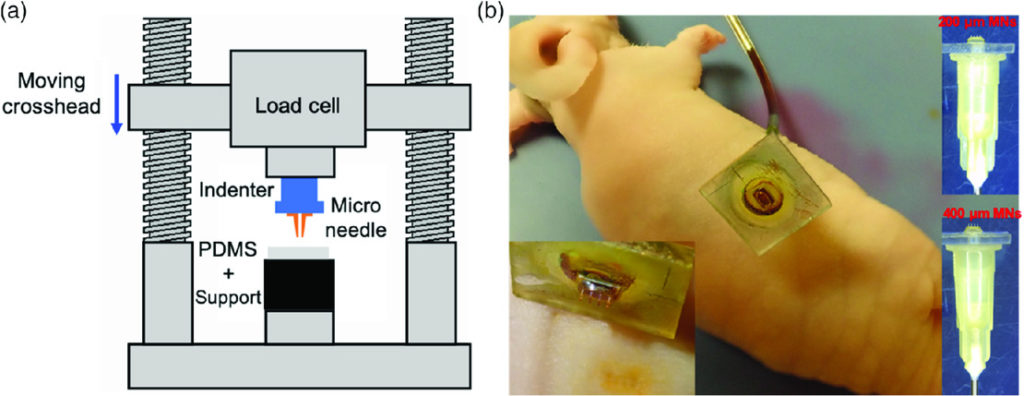

In the recently published ‘Biocompatible 3D Printed Microneedles for Transdermal, Intradermal, and Percutaneous Applications,’ authors Khalil Moussi, Abdullah Bukhamsin, Tania Hidalgo, and Jurgen Kosel explore the use of microneedles in many different medical applications—mainly for procedures that are considered only minimally invasive.
Microneedles are being used today in drug delivery as they can assist in diagnosing and delivering drugs to necessary areas. Numerous materials have been used to date—to include glass, silicon, glass, plastics, and metals. Numerous techniques have been attempted also. The authors point out that they have in some cases even been used in ‘complex microsystems,’ although in general they are used as devices that stand alone.
“Despite their perceived advantages and applications, MNs are yet to see an extensive pervasion in clinical settings. In part, this is due to the complexities associated with the microfabrication techniques used for the development of MNs, which are often multistep, labor intensive, and require expensive cleanroom equipment,” explain the researchers. “In addition, complications arise from the handling and attachment of MNs fabricated with a specific process to a device or structure fabricated with another process.”
3D printing continues to become more of an option in creating MNs, especially through greater evolution of and introduction of SLA and FDM 3D printing and two‐photon polymerization (TPP). FDM 3D printing has been more commonly used so far, and especially with recent projects such as fabrication of biodegradable polymer MNs for transdermal drug delivery. TPP shows potential, however, for 3D printing hollow MNs meant for transdermal delivery in patients, and for this study, the researchers focus on how to attach such MNs to a drug reservoir.

“This approach has already been implemented using standard processing techniques of silicon microfabrication and using metal electrodeposition of a patterned sacrificial mold to create hollow MNs with an attached reservoir,” state the researchers. “However, these processing techniques suffer from the same complexities as mentioned earlier and afford limited control over the MNs geometry and aspect ratio. Thus, with the advent of TPP, it is now feasible to 3D print microstructures having dimensions in the millimeter scale while providing feature sizes with micrometer resolution.”
Overall, results showed ‘excellent linear fit’ as well as FEM simulation. The researchers recognized that the study shows the potential material strength necessary, along with the ability to tailor elasticity through changing parameters like slicing and hatching. The research team created a reservoir of 2 mm3 volume topped with hollow MNs with inner diameter and height ranging from 80 to 120 μm and from 200 to 400 μm.
“Combined with experimental testing, this analysis verified the appropriate dimensions of the MNs that are needed to ensure mechanical stability for a given application. To corroborate the applicability of the 3D printed MNs, they were used for a penetration test into both a skin‐like material and mouse skin. Penetration into skin‐like material allowed the determination of the piercing force which was 0.095–0.115 n,” stated the researchers.
“Confocal microscopy of the mouse skin confirmed the MN array penetration and fluorescent dye delivery 100 and 180 μm deep into the skin for the 200 and 400 μm‐long MNs, respectively. A complementary biocompatibility assessment was performed to investigate the potential of using the technique for direct tissue interfacing or implants, and it has determined that the photoresist has minimal cytotoxicity, which makes it ideal for such applications.”
The study of microneedles continues for researchers, along with continued innovation such as MNs that dissolve under the skin, deliver drugs and communicate through BlueTooth, allow for new types of arrays. What do you think of this news? Let us know your thoughts; join the discussion of this and other 3D printing topics at 3DPrintBoard.com.
[Source / Images: ‘Biocompatible 3D Printed Microneedles for Transdermal, Intradermal, and Percutaneous Applications’]
If you're looking to get architectural 3D animation in the USA, our service provides an exceptional way to bring your architectural concepts to life through dynamic, immersive visuals. Through our platform, you can easily request high-quality 3D animations that showcase your designs in motion, offering a detailed view of your project from multiple angles and perspectives. Whether it's for a real estate development, a commercial building, or an urban planning project, our expert team ensures that every detail is captured in a visually compelling animation.
Through our website, you can seamlessly get architectural 3D animation tailored to your project’s specific needs. With our help, you can offer potential clients or investors an engaging experience that goes beyond static images. By integrating CGI animations with real-world settings, lighting, and textures, our team creates a lifelike experience that allows your audience to interact with your project as though it were already built. This service is perfect for presenting complex designs in a clear, visually attractive way that stands out in the competitive architectural market.




